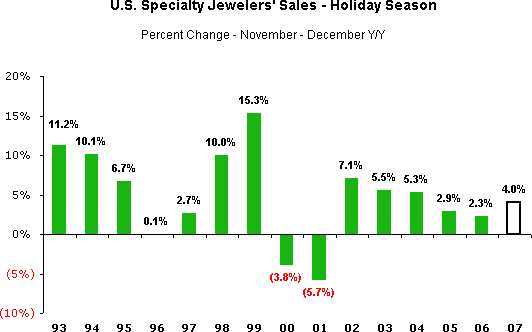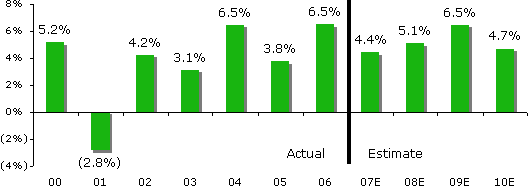IDEX Online Research: A Ho-Ho-Hum Christmas Season - U.S. Holiday Jewelry Sales to Be Up About 4%
October 11, 07
U.S. jewelry sales are projected to rise about 4.0 percent, with a range of 3.5 percent-to-4.2 percent, over last year during the all-important 2007 holiday selling season of November and December, based on research analysis by IDEX Online Research.
However, this range does not tell the whole story. Due to unusually bifurcated market demand, IDEX Online Research is forecasting that guild jewelers – better stores such as Tiffany and Harry Winston – will likely post a sales gain in the 8-12 percent range or higher, while mass market jewelers such as Zale will likely report nearly flat sales.
This year’s forecast is well above last year’s weak gain of 2.3 percent as well as above 2005’s gain of 2.9 percent. However, this year’s projected gain is well below the long term average gain for holiday sales of about 5 percent.
The graph below summarizes holiday sales gains in the U.S. market since 1993.
|
|
Holiday Season: Make-Or-Break For Jewelers
The holiday selling season of November and December is a make-or-break period for U.S. jewelers. Retail jewelers in America typically generate about one-third of their annual sales and up to 100 percent of their yearly profits in this two-month period which includes Christmas, Chanukah and Kwanzaa. Among all retail segments, jewelry is one of the most highly seasonal businesses, with a heavy dependency on November and December sales.
The graph below illustrates jewelry sales by month for the typical U.S. specialty jeweler. It is clear that November and December are the two most important months of the year for sales.
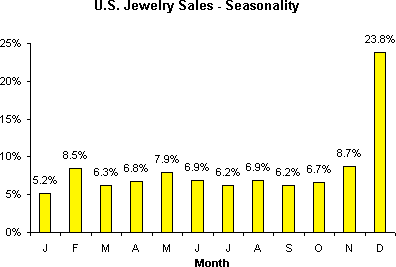
Source: U.S. Dept. of Commerce
Positive Factors: A Relatively Long But Fragile List
If the stars align themselves properly, jewelry demand could far exceed our forecast. However, while the list of positive factors is long, it is fragile. If something misfires, jewelry demand could be below our forecast. The list of factors which will drive jewelry demand in the upcoming 2007 holiday selling season includes the following:
- Energy Costs Won’t Break Budgets – Consumers appear to have adjusted to higher gasoline prices. With energy prices stable – gasoline prices are flat, heating oil is headed lower, and natural gas could decline – shoppers will have some discretionary money in their holiday budgets.
- Wages Continue to Rise – A relatively tight labor market has forced employers to continue to pay workers more. Inflation remains modest, so shoppers should have more money in their wallets.
- Stock Market Is Up – The stock market has been on a roller coaster ride for the past several months, but viewed over the long term, investors have made money. An increase in wealth levels from the stock market is helping to offset some of the losses in the real estate market.
- Consumers Are Shopping for Quality – Shoppers at virtually all income levels are willing to spend money on high-quality goods. The perception is that these goods represent an investment. As a result, merchants which offer high-quality goods at fair prices – in other words, offer a good value – will benefit from this shift in shopping sentiment. This factor is largely responsible for the current bifurcated market.
- High Income Consumers Are Still Shopping – In the U.S., the average household income is around $55,000 annually. High-income households, defined as households with an annual income of $70,000 or greater, are the most important segment for American jewelers. These households, which represent about 30 percent of all households in America, account for roughly 70 percent of all spending on jewelry. These households typically have greater wealth and more discretionary income; thus, a recessionary environment and inflationary prices have less impact on their spending. Further, the current mortgage credit crunch is not affecting this group of consumers as much as it affects lower income consumers. The graph below illustrates the importance of these high-income households on specialty jewelers’ sales.
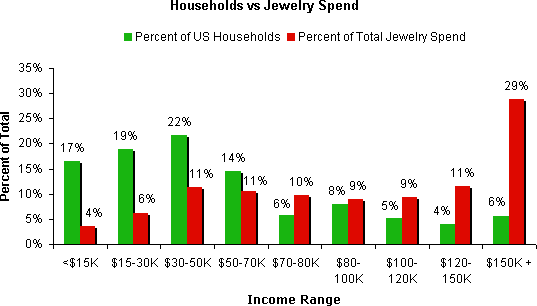 Source: BLS CES |
- Engagement Jewelry Will Help Boost Sales – Jewelers who specialize in bridal jewelry will benefit from engagement ring sales. A disproportionately large number of engagement rings are solid in November and December because Christmas is an especially opportune time for men to propose marriage to women. The graph below illustrates monthly sales of diamond engagement rings in the U.S. market; nearly 80 percent of all women receive a diamond engagement ring prior to their marriage.
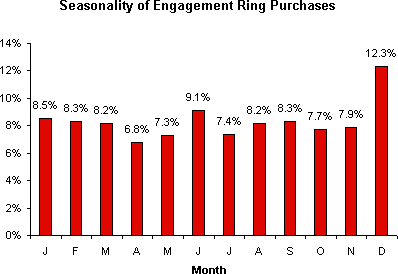 Source: National Jeweler |
- Price Inflation Will Help Reported Sales Gains – For most of the past decade, retail prices of jewelry have fallen. However, in both 2006 and 2007 (year-to-date) jewelry prices are up. Our forecast assumes that jewelry that unit sales of jewelry will be about flat or down slightly; retail price inflation for jewelry could hit +5 percent in 2007, as the graph below illustrates. Thus, the entire holiday sales gain could come solely from higher retail prices rather than an expansion of the market.
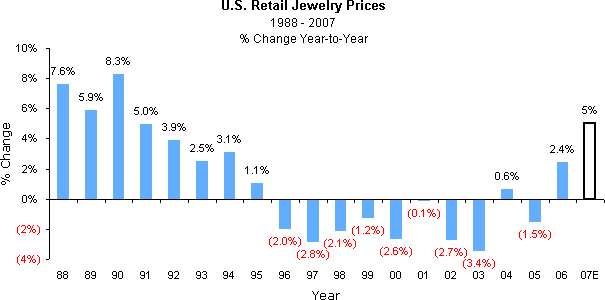 Source: BLS |
- Sales Comparisons to Last Year Are Easy – Economists and mathematicians use this factor frequently to help explain numbers which seem to be an anomaly. Because last year’s sales levels were weak, any modest gain in jewelry sales this year will show up as a notable percentage increase. It doesn’t mean that consumers are spending heavily; it is a function of the math.
- An Extra Shopping Day Could Help – The holiday shopping season typically gets underway right after Thanksgiving. As a result, most forecasters measure the U.S. holiday selling season as the number of days between Thanksgiving (the fourth Thursday in November) and Christmas (invariably December 25). This year, there will be one more day in that period versus last year. Depending on which forecasting service you use, a longer holiday selling season 1) may have no impact on demand; 2) could cause shoppers to procrastinate; or 3) could be a catalyst to fuel consumers to spend more.
- DTC Marketing Programs Will Help – Not only is the DTC planning on heavy marketing spend for diamond jewelry during the 2007 holiday season, but its downstream partners will participate via increased co-op for their retail clients. Journey diamonds are going to be a hot category this year.
- Lower Interest Rates – While lower interest rates won’t have much of an impact on credit card balances – banks keep credit card interest rates high – lower interest rates will have a positive impact on adjustable rate home mortgages and other mortgages that reset periodically based on the prime rate or LIBOR.
- Post-Christmas Period Could Be A Pleasant Surprise – The week or two following Christmas is becoming one of the most important periods in the holiday selling season. Consumers, loaded with gifts of cash and gift cards, will be in the malls. Jewelers traditionally offer huge discounts during this period; we think they are overdoing the discounting. Money burns a hole in the pocket of the typical American. Jewelers who offer a good value will post strong sales, regardless of their price-based promotions.
- We Appear To Be At the Bottom of A Cycle – Far-sighted consumers may realize that we likely are at or near the bottom of an economic cycle, despite negative reports in the media. While the first two quarters of 2008 may reflect only moderate economic growth, all signs point to a strong second half. If consumers perceive that they can the see light at the end of the tunnel, they will loosen their purse strings.
- Jewelry is A “Feel-Good” Purchase – There is an old saying among American consumers: “When the going gets tough, the tough go shopping.” What do they shop for? Something that makes them feel good, like luxury goods such as jewelry.
- Holiday Jewelry Demand Will Be Bifurcated – For many reasons, jewelry demand has been unusually uneven this year, with strong gains among the guild jewelers offering high-quality merchandise at very high price points, while mass market jewelers have been barely able to tread water. This trend will continue through the holiday selling season. In part, we believe it may be part of a broader trend – consumers want to make an “investment” in high quality jewelry. In part, it reflects financial pressures on middle-market consumers. We look for mass market jewelers to post sales about flat to up modestly from last year; guild jewelers will likely post high single digit or low double digit sales gains.
Negative Factors: Could Cause A Spending Crunch
The list of negative factors is shorter this year than the list of positive factors. However, if a few of the negative factors get worse, they could offset everything on the positive side of the ledger. The list of negative factors affecting holiday jewelry sales includes the following:
- Wealth Levels Are Under Siege – The largest asset on a consumer’s balance sheet is his or her home. The housing market is contracting, and home prices are down. Thus, the value of the typical shopper’s home has declined over the past year. When consumers feel less wealthy, they tighten their purse strings.
- Personal Debt Burdens Are High – American consumers typically carry some of the highest debt burdens of any society in the world. As a result of heavy borrowing against their tangible assets, such as their homes, as well as borrowing against future income flows, their debt burden and financial obligations are very high. While we would argue that these obligations remain manageable, they threaten jewelry purchases, since roughly 50 percent of all jewelry bought in America is purchased using debt, typically a monthly payment plan. The only good news is that there are no signs of reduced credit availability outside of the mortgage market.
- Mortgage Equity Withdrawals Are Down – As a result of falling home prices and high debt burdens, consumers are no longer relying as heavily on home equity loans to support their current spending. We think this represents a long term positive for the financial health of American consumers, but it will hurt discretionary spending in the short term.
- A Weak U.S. Dollar Could Fire Up Inflation – While core inflation is down, a weaker dollar will make goods produced overseas more expensive. Long term, this will fuel inflation, which robs consumers of buying power.
- Other Risks Abound – Assuming that we maintain status quo, the holiday selling season will show moderate sales gains. However, any shock – perhaps only a small shock – could be devastating to consumer spending. If oil prices suddenly jump, if new mortgage credit problems are uncovered, if some geopolitical battle erupts – any of these and other risks exist that could disrupt holiday spending.
- There Is No Buffer in Consumers’ Budgets – Americans aren’t saving any money. Thus, they have no buffer in their household budgets for a sharp rise in any expense category. If income suddenly falls, or if a single cost suddenly jumps, they don’t have the power to temporarily suspend saving – because their savings rate is nil.
- Low Inventory Levels Among Jewelers – A soft holiday selling season could become a self-fulfilling prophesy, based on our research which shows that many jewelers are under-inventoried. Tiffany was surprised by the strength of its second quarter sales and ended the quarter with inventory levels that were not only below plan, but which hurt sales because Tiffany could not meet demand. Further, too many jewelers have only basics in their inventory. Unless they have something exciting, fashionable, and new, consumers will move on to the next retailer, in their search for quality and value.
- Online Jewelry Merchants Will Take Market Share – Online specialty jewelers such as Blue Nile will continue to take market share from store-based jewelers in the 2007 holiday selling season. Price will be one important factor which will cause shoppers to buy online, but for time-pressed shoppers, online shopping offers a great convenience. Store-based specialty jewelers will need to develop an online strategy that will get shoppers into their stores.
- Tuesday Christmas Will Hurt – The only day worse than a Tuesday Christmas is a Monday Christmas, like we had in 2006. Shoppers may cease shopping on Saturday evening this year, and not return to the stores until Wednesday, the day after Christmas. We’re betting that there will be a lot of price-chopping on December 23 and 24, in an effort to get consumers into the malls. This could boost mall traffic and help jewelers.
Total Holiday Retail Sales Forecasted to Be Up
Several forecasts have been made for retail sales in the 2007 holiday selling season. Consensus predictions seem to fall in the +4.0-4.5 percent range. This is at the high end of our jewelry forecast, but it reflects tradition: when retail sales are soft, jewelry demand is softer. When retail sales are strong, jewelry sales are stronger. In other words, jewelry demand is more discretionary – some would say more volatile or more cyclical – than total retail sales.
Early reports about the prospects for the holiday season from media analysts appear to be somewhat pessimistic, though this seems to be the underlying tone of most media reports in today’s world. This pessimism is based on weak sales in September, which the media says is a proxy for the upcoming holiday selling season. Unfortunately – or perhaps fortunately – the media has it wrong: the September Back-to-School retail season is no longer a proxy for holiday sales. Up until the early 1990s, Back-to-School retail sales often correlated to holiday sales. Since then, however, several factors have reduced the correlation. For example, the Back-to-School season begins in early August and runs though mid-October, rather than just a couple of weeks in early September. Further, consumers seem to wait until cold weather before they buy winter clothing; in the past, winter clothing was a staple purchase in early September. Unseasonably hot temperatures this year have kept consumers out of clothing stores.
For jewelers, the economic factor with the highest correlation to jewelry demand is GDP. When GDP is strong, jewelry demand is strong; when GDP is soft, jewelry sales are weak. Other factors, such as unemployment, interest rates, job creation and wage gains, simply don’t have as high of a correlation.
Consumer Confidence ≠ Retail Sales
Many people try to correlate consumer confidence levels with retail sales. They believe that if consumers are pessimistic, they won’t shop. The correlation between retail sales and consumer confidence is about as low as two sets of factors can get. Consumer confidence simply measures the mood of consumers. Even the Conference Board says that it is not a predictor of retail sales. Don’t fall for media reports that try to correlate consumer confidence and retail sales; despite the apparent logic, it just isn’t so.
Christmas Always Comes
Despite the negative media stories going into the holiday selling season, Christmas always comes. There is another American adage: Baseball may be this country’s national pastime, but shopping is its passion. That’s why they are called “consumers” and “shoppers.” Americans invented recreational shopping. People will be in the malls. It is up to retail jewelers to provide the opportunity for those shoppers to spend their money on jewelry versus some other merchandise.
Outlook for 2008: Slow Start, Strong Finish
Based on the relatively high correlation between economic growth and jewelry demand, we believe that jewelry demand will be relatively weak in the first half of 2008, followed by solid gains in the second half. Consensus economic forecasts call for GDP to show only modest gains during the first two quarters of 2008, with accelerating gains in the third and fourth calendar quarters.
The graph below summarizes our preliminary sales forecast for the U.S. jewelry market in 2008 and beyond.
| U.S. Jewelry Sales Gains |
